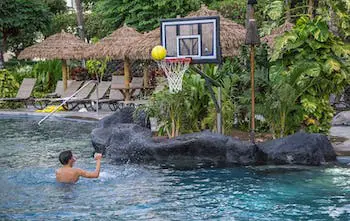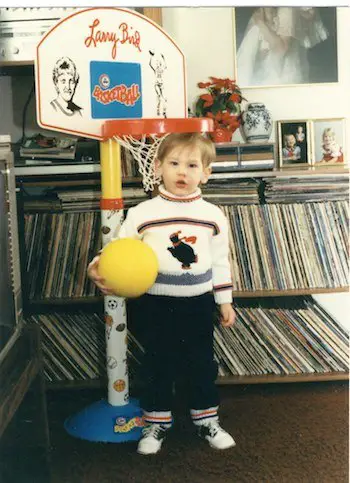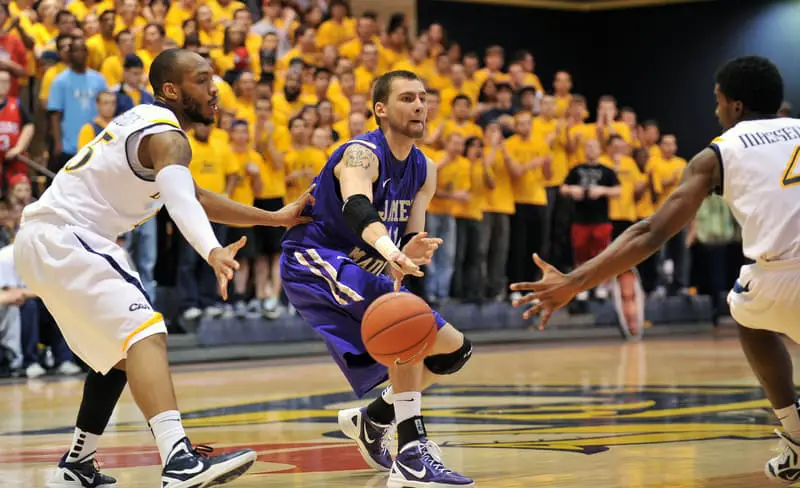NBA Commissioner Adam Silver takes the stage as the final presenter of the night, and there’s a palpable sense of anticipation in the AIR.
As he reads out a name from an envelope, the audience stands and breaks out into applause.
18-year-old Greek of Nigerian descent also stands up with a huge smile on his face. His name is Giannis Antetokounmpo, and this is HIS MOMENT.
Your Guide
 Edis Hajlovac
Edis Hajlovac
After embracing the people who accompanied him tonight, he walks onto the stage, shakes the Commissioner’s hand, and accepts his KIA NBA MVP award.
It’s been more than a DECADE since the last time a non-US player won that award.
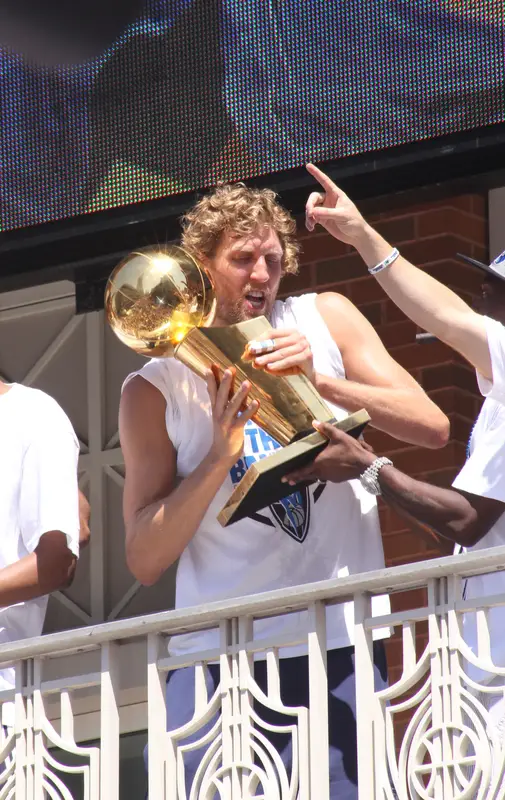
Giannis was not the only international player with a cause for celebration that night.
He was JOINED by a Slovenian Rookie of the Year, Luka Dončić, a Cameroonian Most Improved Player, Pascal Siakam, and a French Defensive Player of the Year Rudy Gobert.
For them, it was a night to remember, but it was also a testament to just how much the international game has advanced over the years.
While the achievements of these players are MONUMENTAL, this will not be their story.
This will rather be a story of what made it possible for them to be in the positions they were in on that night…
..A story of how the NBA reached their parts of the world and of those who opened the gates of the league to international talent.
Looking For A Competitive Edge
There’s no denying that the NBA is one of the most popular sports leagues in the world.
While the good business decisions made by the league management have been a MAJOR FACTOR towards achieving that popularity, they are only a part of the greater whole.
To truly understand how the league got to where it is today, we must recognize the individuals from both sides of the aisle who jump-started the league’s international revolution and the events that added FUELED it.
The game of basketball was GLOBAL long before the NBA ever existed, thanks to the work of YMCA educators and missionaries.
As they traveled the world, they interacted with the locals wherever they went and, inadvertently or not, spread the game of basketball.
For a long time after its creation in 1946, the NBA was neither INTERESTED in or ATTRACTIVE to international talent or audiences.
The NBA didn’t always have massive media coverage, and the game of basketball was not developed enough to allow for much internationalization.
This drastically changed when the NBA entered its golden age.
The ‘80s and ‘90s are often regarded as the golden age of the NBA that gave us all-time greats like Magic Johnson, Larry Bird, and His Airness Michael Jordan, among many others.
More money started POURING into the league as a result of the popularity generated by the league’s star players, and more people around the world started following the games when they could. This put the international players on notice.
Basketball was played in a way that would make the analytics-driven basketball coaches and executives rip their hair out with PLENTY of inefficient mid-range shots and low-post isolations for towering centers.
It was a common belief that a championship-caliber team needed a STAR CENTRE. Rivalries flared, and a culture of winning was created.
Either you won, or you didn’t matter. There were no points for second place. This cutthroat environment made teams look for anything that could give them an EDGE.
The First African Stars
This was also the time when the first NBA stars from Africa and Europe made names for themselves.
The first pick of the 1984 NBA draft was Hakeem Olajuwon, a Nigerian center that came to the US to play for the University of Houston.
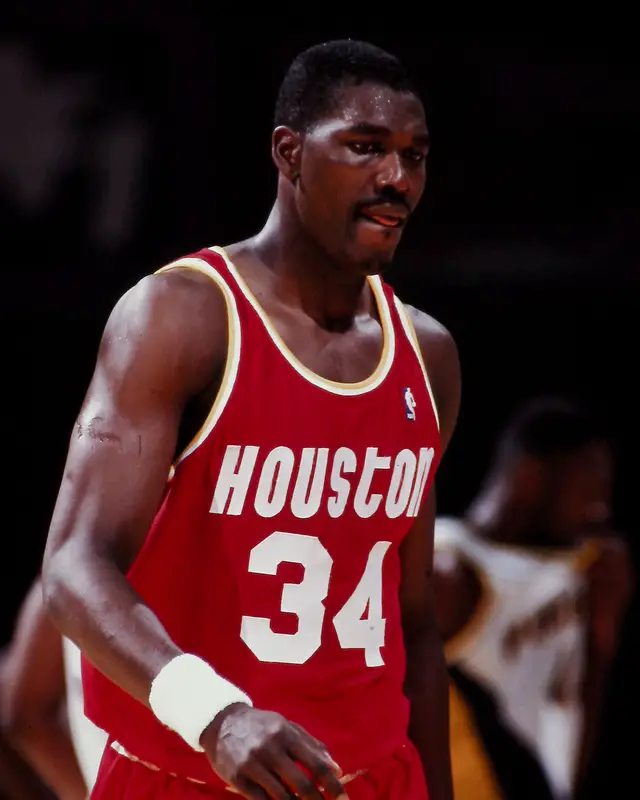
His arrival revolutionized the way the CENTRE position was played.
While many of his peers relied on BRUTE STRENGTH and a few select scoring moves, Hakeem relied on finesse and pure skill.
Hakeem grew up playing soccer, an incredibly popular sport in his native Nigeria, and he only started playing basketball in high school.
The FOOTWORK he acquired playing soccer translated incredibly well to basketball, and years of quality coaching have honed his instincts and basketball IQ.
His low-post footwork was poetry in motion, his BAG OF TRICKS seemed bottomless, and his shot-blocking was second to none.
Hakeem quickly established himself as the league’s most unguardable center and an elite rim protector.
He became the first African ever to win the MVP award and led his Houston Rockets to two championships in ’94 and ’95.
Another future African NBA star joined the league in 1991 when the Denver Nuggets Selected Dikembe Mutombo from Congo as the fourth overall pick.
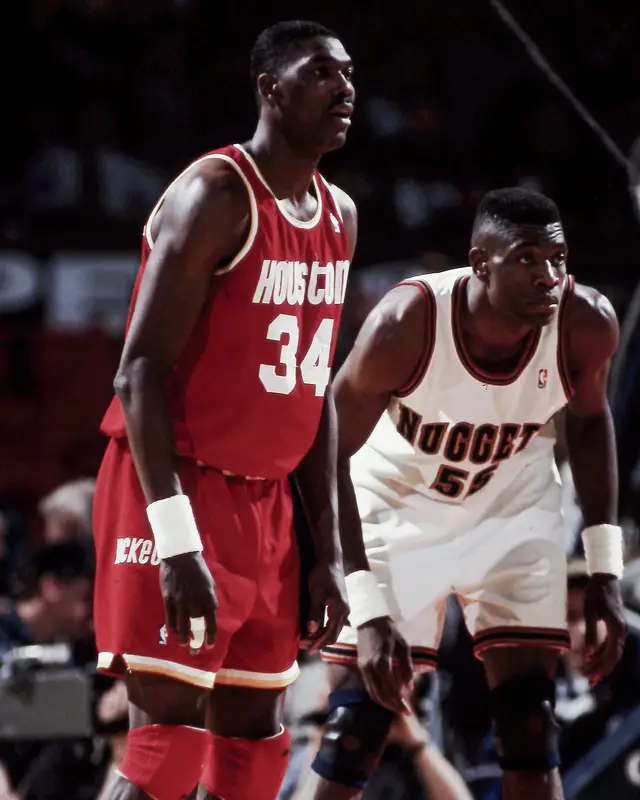
Mutombo came to the US to attend Georgetown, thanks to a USAID scholarship. Just like Hakeem, Dikembe made a name for himself before ever stepping on an NBA court.
Together with his Georgetown teammate Alonzo Mourning, Dikembe developed a reputation as one of the best defensive centers in the country.
A reputation that he more than lived up to in the NBA.
While Mutombo never managed to win an NBA championship, his eight All-Star appearances and four Defensive Player of the year award will forever serve as a reminder of the IMPACT he had on the league during his 18-year career.
Olajuwon and Mutombo came to the NBA at the best possible time to not only maximize their impact on the league but also open the league’s eyes to the potential of African basketball players.
Their careers have both inspired and paved the way for the new crop of young African players ready to make their mark on the NBA.
Breaking The European Stereotype
Spot-up shooter, strictly a role-player, and not very creative. In the words of Chris Mulling, this was the stereotype surrounding European players in the NBA prior to 1989.
There was definitely some amazing talent in Europe, with the Yugoslavian and Soviet national teams being juggernauts that could go head-to-head with the US team in international competition.
Unfortunately, politics and the Cold War prevented many of Europe’s greatest players from going to the NBA. That is until a Soviet/Lithuanian player Šarūnas Marčiulionis decided to take on the establishment.
Marčiulionis won the Olympic gold against Team USA in the 1988 Olympics, but his QUALITIES were known by some in the US as early as 1985.
That was the year when Donnie Nelson, son of Golden State Warriors coach Don Nelson, first played against Marčiulionis while on tour with Athletes in Action.
Donnie recommended to his dad that they should try to bring Marčiulionis to play in the US, and the Atlanta Hawks had the same goal in mind.
Following multiple failed attempts to get the Soviet officials to allow him to play in the US, Marčiulionis decided to roll the DICE and leave on his own.
This was a huge risk, but in 1989, the Soviet Union was slowly falling apart, and Marčiulionis decided that he had a chance to succeed.
The night before his departure, chess champion Garry Kasparov, who helped him prepare for the trip, told him that by this time tomorrow, he would either be one of the RICHEST MEN in the country or in [a work camp] in Siberia.
Fortunately, it was the former, and Marčiulionis wasted no time establishing himself as a physical force and a pure scorer with plenty of creativity.
Both of those things were completely atypical for a European player in the eyes of many Americans.
While he never reached an All-Star level of play, Marčiulionis was nonetheless a solid NBA player who made the NBA reconsider how good European players can be.
European legend Dražen Petrović also crossed over to the NBA in 1989 after winning pretty much anything that could be won in Europe.
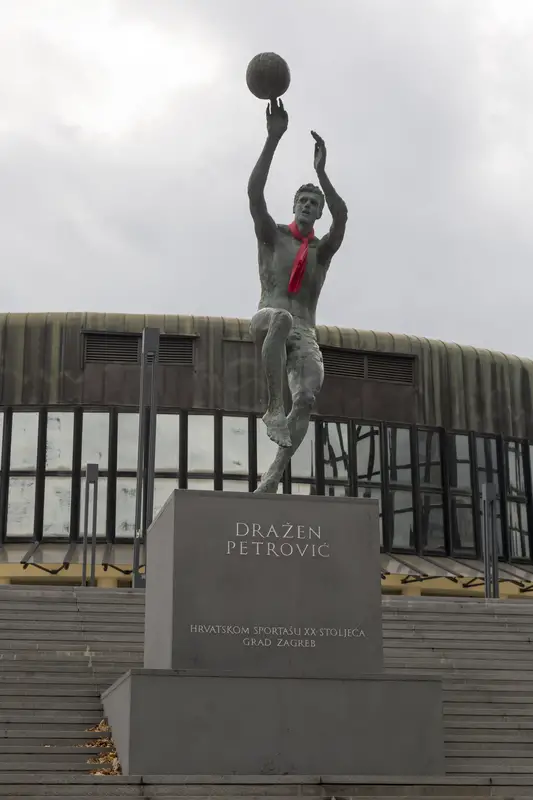
(Statue of Croatian Basketball legend Drazen Petrovic)
In his first two seasons, Dražen was a victim of the European stereotype in Portland. He saw little playing time; even when he did, he was utilized purely as a spot-up shooter.
Dražen was known as an aggressive guard who was used to creating his own shot in Europe and LIMITING him like that was wasting his potential.
Fortunately, he was traded to the New Jersey Nets in his second NBA season, a team where he could FINALLY be himself.
The New Jersey Nets version of Dražen was a different beast entirely.
He quickly emerged as the leader of his team. A player who feared nobody and who was both willing and able to compete with the likes of Michael Jordan, Reggie Miller, and other top shooting guards of the era.
His stellar play resulted in an All-NBA team selection in 1993, the first-ever for a European player. This was only supposed to be the first of his many NBA ACCOLADES, but his life was tragically cut short by a car accident he got into in June of 1993.
The NBA was slowly starting to understand what European players were capable of, thanks in large part to Marčiulionis and Dražen.
A few other international players were making names for themselves in the NBA in the early ‘90s, but in the summer of 1992, the basketball world would be changed forever.
The Dream Team
Summer Olympics held in Barcelona in 1992 marked the first international tournament where the US team was made up of NBA players.
The Dream Team players were known worldwide even before the Olympics and welcomed like ROCKSTARS.
The Soviet Union and Yugoslavia had both fallen apart, which meant that the only two teams that could come close to challenging the Americans were out of the picture.
The Dream Team rolled over the competition with show-stopping performances in every single game.
Many of their opponents were in AWE, some even bringing cameras to take photos from the bench.
The crowd was equally enchanted as they had never seen the game played like this before. Kids all around the world wanted to be like Mike, pass like Magic, or dunk like Barkley.
The Dream Team has shown the appeal of the NBA to the average basketball fans worldwide and INSPIRED countless kids around the world to pick up a basketball.
A Global Expansion
The late ‘90s saw the second three-peat of Jordan’s Chicago Bulls, featuring Australian Luke Longley as their starting center.
Longley was the FIRST Australian to ever play in the NBA.
Longley and Andrew Bogut, fellow Australian and first overall pick in 2005, helped popularize the game in Australia and give the fans in their NATIVE country someone to identify with the NBA.
The 1998 draft gave us what is probably the biggest international NBA sensation to date – Dirk Nowitzki.

As a 7-footer who can shoot, dribble, and defend, he quickly took the league by storm with his unique set of skills and playstyle.
The hunt was on as NBA teams were starting to send scouts all over Europe in search of the NEXT Dirk.
In 2001, Dirk became the second European ever to be named to an All-NBA team and the first to win the MVP award. After 21 years, 14 All-Star appearances, and a championship ring in 2011,
Dirk retired as the most accomplished European NBA player to date and is living proof that a European franchise player could lead the team to success.
Following the turn of the millennium, league management was looking for ways to increase the popularity of the league in different parts of the world.
The rise of the internet was an opportunity that the NBA has made VERY GOOD use of to bring its content to fans around the globe.
To this day, the league’s willingness to innovate and evolve on the digital front deserves nothing but praise.
As technology was RAPIDLY IMPROVING, so did the NBA’s ability to bring more content in a digital format and make the experience more immersive for fans worldwide.
However, simply bringing NBA content to certain parts of the world was not enough. To truly buy in, people need stars from their region they can identify with.
Soccer dominated the sports landscape of South America at the time, just as it does today, but that didn’t mean basketball was neglected. Argentina won the first-ever basketball World Cup back in 1950.
Oscar Schmidt, considered by many to be the best player to never play in the NBA (drafted in 1984 but decided to play elsewhere), was Brazilian.
Basketball had a following in South America, and the region had several NBA players already, but it failed to produce an NBA star. Until the San Antonio Spurs picked Manu Ginobili in 1999.
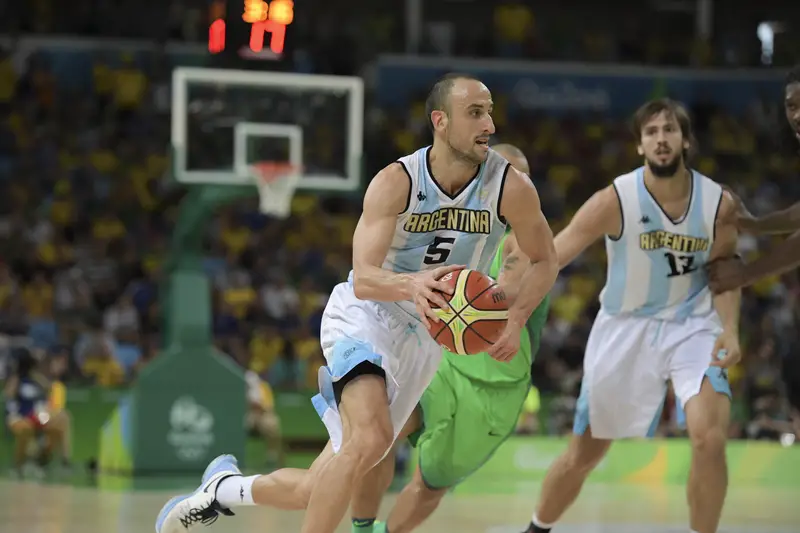
The Spurs are probably the best team in the league when it comes to identifying hidden international GEMS and making them shine in the NBA.
Manu was a diamond in the rough, and they knew it.
His game had a certain FLAIR and Bravado to it, which was a delight for the crowd and a nightmare for coach Popovich at times.
Popovich soon understood that he wouldn’t be able to change who Manu was, so he FOCUSED on channeling Manu’s talents in a direction that would help the team.
Over the next decade and a half, Manu was a part of the Spurs core that won 4 NBA championships, and Manu himself added two All-Star appearances to his resume.
Manu and fellow Argentinian Luis Scola (drafted in 2002 and made his NBA debut in 2005) have helped establish South America as a region that is capable of producing IMPACT PLAYERS in the NBA.
Only one major region lacked meaningful representation in the NBA, and it was a market where the NBA was increasingly looking to establish itself a presence – ASIA.
A breakthrough on that front came in 2002 when Chinese center Yao Ming was drafted first overall by the Houston Rockets, a team with a history of international star centers.
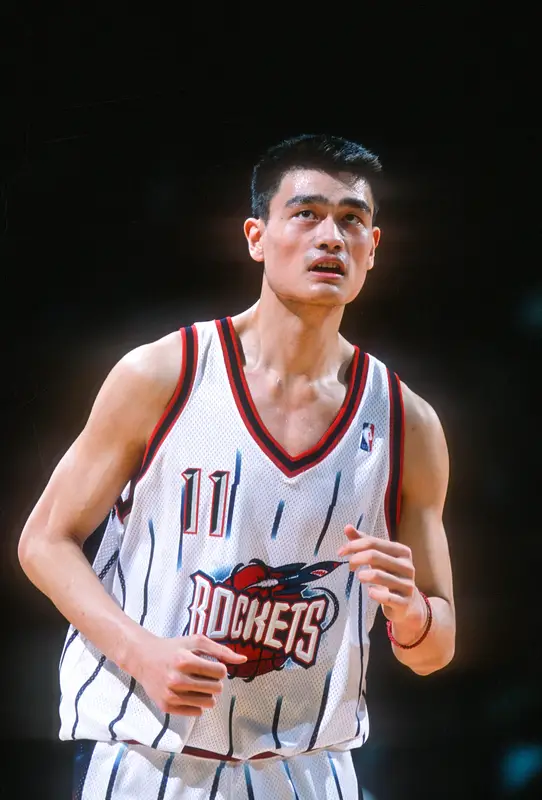
Yao was a complete MYSTERY to the US fans, and his debut was eagerly anticipated by both US and Chinese fans.
If he could establish himself in the NBA, it would go a long way toward popularizing the NBA in China and the rest of Asia.
Yao was even better than advertised, a dominant force of both sides of the floor.
Fans around the world LOVED him, and he made the All-Star team in each of his 8 NBA seasons.
Even with all his success, there is still the question of what could have been as his career was cut short due to multiple injuries.
He was an incredibly influential player not just for his in-game performances but also for the work he did to popularize the NBA in China.
Building Lasting Relationships
The NBA was now a TRULY GLOBAL Phenomenon, but it did not take this popularity for granted.
Over the last two decades, the league took its newfound popularity seriously and introduced many programs aimed at building relationships with fans and helping develop young local players worldwide.
Many teams started visiting European teams to play preseason games.
The league even moved some official preseason and regular-season games to venues on different continents to give international fans the taste of an authentic NBA game experience.
These Global Games have been so popular that the league office is very likely to expand the program going forward.
Helping international talent grow and improve has also been one of the main points on the NBA’s international agenda.
Dozens of dedicated basketball camps have been run by NBA together with FIBA as a part of the Basketball Without Borders programs.
Through the BWB program, top youth players from across the globe had the chance to train and develop under top NBA players and coaches.
NBA players and coaches, both active and retired, are acting as regional ambassadors and often travel to different continents either for fan events or charity missions as a part of NBA’s projects or even on their own.
The international journey of the NBA would not have been possible without the players who forced the league to RECOGNIZE the quality of international talent through their play and achievements…
..but also without the pioneering coaches and team executives who gave those players a chance to show the world what they’re capable of at the highest level.
The league management must also be recognized for how they adapted to the growing international influence and popularity of the NBA and for the work done to gain and BUILD meaningful relationships with the NBA’s ever-growing international fan base.
All of this gave us the truly INTERNATIONAL NBA we know and love today, and everyone is better off because of it – the league, the fans, and the game of basketball as a whole.
References/Further Learning Materials:
- The Other Dream Team (2012 documentary)
- The Year of the Yao (2004 documentary)
- The Dream Team (2012 documentary)
